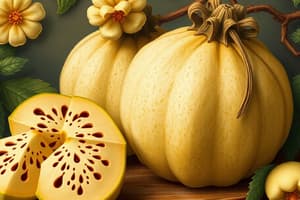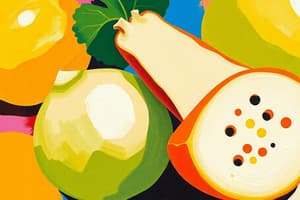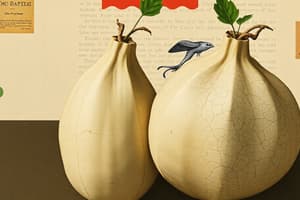Podcast
Questions and Answers
What type of plant is jicama classified as?
What type of plant is jicama classified as?
- Shrub
- Annual flower
- Herbaceous vine (correct)
- Woody tree
What characteristic defines jicama as a perennial plant?
What characteristic defines jicama as a perennial plant?
- It produces flowers annually.
- It is a trees that can live for decades.
- It only grows in summer.
- It lives longer than two years. (correct)
Which region is most widely associated with the domestication of jicama?
Which region is most widely associated with the domestication of jicama?
- Southeast Asia
- North America
- Southern Africa
- Central America (correct)
Which part of the jicama plant is utilized for consumption?
Which part of the jicama plant is utilized for consumption?
What is the first step in processing jicama for use?
What is the first step in processing jicama for use?
What is the primary economic purpose for which Jatropha is grown?
What is the primary economic purpose for which Jatropha is grown?
Which of the following describes the Jatropha plant?
Which of the following describes the Jatropha plant?
What is the step that comes immediately after drying the harvested seeds of Jatropha?
What is the step that comes immediately after drying the harvested seeds of Jatropha?
What is the purpose of filtering the extracted oil from Jatropha seeds?
What is the purpose of filtering the extracted oil from Jatropha seeds?
Which statement about the native distribution of Jatropha is accurate?
Which statement about the native distribution of Jatropha is accurate?
Which statement accurately describes true roots?
Which statement accurately describes true roots?
What distinguishes corms from bulbs?
What distinguishes corms from bulbs?
Which vegetable crop is classified under the category of green vegetables?
Which vegetable crop is classified under the category of green vegetables?
Which of the following plants is an example of a bulb?
Which of the following plants is an example of a bulb?
What is the primary characteristic of taproots?
What is the primary characteristic of taproots?
What significant agricultural impact occurred due to the potato blight in Ireland?
What significant agricultural impact occurred due to the potato blight in Ireland?
Which characteristic increases the susceptibility of the potato crop to pest and disease outbreaks?
Which characteristic increases the susceptibility of the potato crop to pest and disease outbreaks?
What is the main reason for cooking taro before consumption?
What is the main reason for cooking taro before consumption?
Which yam species is recognized as producing the largest tubers?
Which yam species is recognized as producing the largest tubers?
What common mistake is made regarding yams in relation to sweet potatoes?
What common mistake is made regarding yams in relation to sweet potatoes?
What was the main reason for the decline in the reliability and affordability of spice supply to Europe before 1499?
What was the main reason for the decline in the reliability and affordability of spice supply to Europe before 1499?
Which company first monopolized the trade in spices such as black pepper?
Which company first monopolized the trade in spices such as black pepper?
Which of the following mint family spices is widely known for its use in Italian cooking?
Which of the following mint family spices is widely known for its use in Italian cooking?
What characteristic of drying mint family leaves affects their use as spices?
What characteristic of drying mint family leaves affects their use as spices?
Which region is primarily associated with the native spices of the Mint family?
Which region is primarily associated with the native spices of the Mint family?
What role did spices play in ancient food preparation?
What role did spices play in ancient food preparation?
How did the Venetian merchants impact the Spice Trade?
How did the Venetian merchants impact the Spice Trade?
What was a consequence of Marco Polo’s expeditions between 1269-1294?
What was a consequence of Marco Polo’s expeditions between 1269-1294?
What type of chemicals are primarily responsible for the aromas of spices?
What type of chemicals are primarily responsible for the aromas of spices?
What change happened in Europe during the Dark Ages in terms of spice usage?
What change happened in Europe during the Dark Ages in terms of spice usage?
What factor primarily contributes to Brazil's high energy balance in bioethanol production compared to the U.S.?
What factor primarily contributes to Brazil's high energy balance in bioethanol production compared to the U.S.?
What measurement indicates the efficiency of bioethanol production?
What measurement indicates the efficiency of bioethanol production?
What was a significant consequence of establishing large sugar cane plantations in the Caribbean during the 1500s?
What was a significant consequence of establishing large sugar cane plantations in the Caribbean during the 1500s?
Which plant is noted for producing a significantly high volume of bioethanol per hectare in Brazilian plantations?
Which plant is noted for producing a significantly high volume of bioethanol per hectare in Brazilian plantations?
Which statement accurately describes the primary difference between starch and cellulose?
Which statement accurately describes the primary difference between starch and cellulose?
What is the main structural component of plant cell walls?
What is the main structural component of plant cell walls?
Which factor contributes to the classification of bioethanol as a sustainable energy source?
Which factor contributes to the classification of bioethanol as a sustainable energy source?
Which statement about monosaccharides and disaccharides is correct?
Which statement about monosaccharides and disaccharides is correct?
What role does amylase play in the digestion of starch?
What role does amylase play in the digestion of starch?
What distinguishes saturated fats from unsaturated fats?
What distinguishes saturated fats from unsaturated fats?
What process is used to convert unsaturated fatty acids into saturated ones?
What process is used to convert unsaturated fatty acids into saturated ones?
What health risk is associated with trans fatty acids produced from hydrogenation?
What health risk is associated with trans fatty acids produced from hydrogenation?
What is one of the main characteristics of biodiesel compared to petroleum-based diesel?
What is one of the main characteristics of biodiesel compared to petroleum-based diesel?
Which oil is known for creating soft, heavy-lathering soap?
Which oil is known for creating soft, heavy-lathering soap?
What is a potential drawback of using biodiesel derived from canola oil in cold weather?
What is a potential drawback of using biodiesel derived from canola oil in cold weather?
What is the primary source from which sodium cocoate is derived?
What is the primary source from which sodium cocoate is derived?
What distinguishes extra virgin olive oil from other types of olive oil?
What distinguishes extra virgin olive oil from other types of olive oil?
Which of the following statements accurately describes the cultivation of peanuts?
Which of the following statements accurately describes the cultivation of peanuts?
What is a notable culinary use of sesame oil?
What is a notable culinary use of sesame oil?
Which nutrient in sesame seeds contributes to their health benefits?
Which nutrient in sesame seeds contributes to their health benefits?
What is a common application for cottonseed oil?
What is a common application for cottonseed oil?
What is the main economic use of the latex produced by the Para rubber tree?
What is the main economic use of the latex produced by the Para rubber tree?
What is the process of curing natural rubber primarily aimed at achieving?
What is the process of curing natural rubber primarily aimed at achieving?
Which compound is primarily responsible for the elastic properties of natural rubber?
Which compound is primarily responsible for the elastic properties of natural rubber?
What happens to raw or 'crude' rubber when it is subjected to cooling?
What happens to raw or 'crude' rubber when it is subjected to cooling?
Where is the majority of natural rubber currently produced, and why?
Where is the majority of natural rubber currently produced, and why?
What is a primary advantage of using natural rubber in modern radial tires?
What is a primary advantage of using natural rubber in modern radial tires?
Which country is NOT a major producer of natural rubber?
Which country is NOT a major producer of natural rubber?
What was a significant outcome for indigenous rubber tappers during the rubber boom?
What was a significant outcome for indigenous rubber tappers during the rubber boom?
Which method did the Mayans use to increase the durability of rubber?
Which method did the Mayans use to increase the durability of rubber?
Flashcards
Jicama Family
Jicama Family
Jicama belongs to the Pachyrhizus genus.
Jicama Plant Type
Jicama Plant Type
Jicama is a herbaceous herb, perennial plant.
Jicama Origin
Jicama Origin
Jicama was first domesticated in somewhere in the Americas.
Jicama Main Growing Regions
Jicama Main Growing Regions
Signup and view all the flashcards
Jicama Part Used
Jicama Part Used
Signup and view all the flashcards
Jatropha Family
Jatropha Family
Signup and view all the flashcards
Jatropha plant type
Jatropha plant type
Signup and view all the flashcards
Jatropha Use
Jatropha Use
Signup and view all the flashcards
Jatropha seed processing
Jatropha seed processing
Signup and view all the flashcards
Jatropha Oil Production
Jatropha Oil Production
Signup and view all the flashcards
Root Crop
Root Crop
Signup and view all the flashcards
Taproot
Taproot
Signup and view all the flashcards
Bulb
Bulb
Signup and view all the flashcards
Green Vegetable Crop
Green Vegetable Crop
Signup and view all the flashcards
Allium genus
Allium genus
Signup and view all the flashcards
Potato Origin
Potato Origin
Signup and view all the flashcards
Irish Potato Famine Cause
Irish Potato Famine Cause
Signup and view all the flashcards
Potato Propagation Method
Potato Propagation Method
Signup and view all the flashcards
Yam Types
Yam Types
Signup and view all the flashcards
Taro Characteristics
Taro Characteristics
Signup and view all the flashcards
Spices
Spices
Signup and view all the flashcards
Spice use in history
Spice use in history
Signup and view all the flashcards
Crusades and Spice Trade
Crusades and Spice Trade
Signup and view all the flashcards
Spice Trade and Marco Polo
Spice Trade and Marco Polo
Signup and view all the flashcards
Volatile Oils in Spices
Volatile Oils in Spices
Signup and view all the flashcards
Spice trade route
Spice trade route
Signup and view all the flashcards
Vasco da Gama's voyage
Vasco da Gama's voyage
Signup and view all the flashcards
Dutch/British companies
Dutch/British companies
Signup and view all the flashcards
Plantation agriculture
Plantation agriculture
Signup and view all the flashcards
Mint Family spices
Mint Family spices
Signup and view all the flashcards
Sugar
Sugar
Signup and view all the flashcards
Starch
Starch
Signup and view all the flashcards
Cellulose
Cellulose
Signup and view all the flashcards
Gasoline
Gasoline
Signup and view all the flashcards
Bioethanol
Bioethanol
Signup and view all the flashcards
Bioethanol Energy Balance
Bioethanol Energy Balance
Signup and view all the flashcards
Bioethanol Production Efficiency
Bioethanol Production Efficiency
Signup and view all the flashcards
Sugar Cane Bioethanol
Sugar Cane Bioethanol
Signup and view all the flashcards
Sugar Cane Plantation Yield
Sugar Cane Plantation Yield
Signup and view all the flashcards
Sugarcane Origins
Sugarcane Origins
Signup and view all the flashcards
Plant Oils
Plant Oils
Signup and view all the flashcards
Saturated Fats
Saturated Fats
Signup and view all the flashcards
Unsaturated Fats
Unsaturated Fats
Signup and view all the flashcards
Hydrogenation
Hydrogenation
Signup and view all the flashcards
Trans Fatty Acids
Trans Fatty Acids
Signup and view all the flashcards
Soap from plant oils
Soap from plant oils
Signup and view all the flashcards
Commercial soap detergents
Commercial soap detergents
Signup and view all the flashcards
Biodiesel Fuel
Biodiesel Fuel
Signup and view all the flashcards
Canola Oil
Canola Oil
Signup and view all the flashcards
Biodiesel production efficiency
Biodiesel production efficiency
Signup and view all the flashcards
Virgin Olive Oil
Virgin Olive Oil
Signup and view all the flashcards
Sesame Seeds
Sesame Seeds
Signup and view all the flashcards
Peanut Oil
Peanut Oil
Signup and view all the flashcards
Cottonseed Oil
Cottonseed Oil
Signup and view all the flashcards
Extra Virgin Olive Oil
Extra Virgin Olive Oil
Signup and view all the flashcards
Plant Latex Composition
Plant Latex Composition
Signup and view all the flashcards
Para Rubber Tree
Para Rubber Tree
Signup and view all the flashcards
Vulcanization
Vulcanization
Signup and view all the flashcards
Lactifer Vessels
Lactifer Vessels
Signup and view all the flashcards
Elastomer
Elastomer
Signup and view all the flashcards
Natural Rubber Source
Natural Rubber Source
Signup and view all the flashcards
Synthetic Rubber Use
Synthetic Rubber Use
Signup and view all the flashcards
Rubber's Applications
Rubber's Applications
Signup and view all the flashcards
Indigenous Rubber Use
Indigenous Rubber Use
Signup and view all the flashcards
Rubber Production History
Rubber Production History
Signup and view all the flashcards
Study Notes
Jicama (Pachyrhizus erosus)
- Family: Pea family (Fabaceae)
- Type: Herbaceous vine
- Lifespan: Perennial (lives more than two years)
- Native distribution: Mexico and Central America
History as a Food Plant
- Domestication: Mexico, archaeological sites dating back to 3000 BC. Also found in Peru.
- Major growing regions: Central America and Southeast Asia.
- Use in Central America: Staple food for centuries.
- Use in Southeast Asia: Introduced by the Spanish in the 17th century, now popular in countries like Philippines, China.
Utilization
- Part used: Tuberous root
- Processing:
- Harvesting: Taproot system, harvested from the ground.
- Peeling: Thin, brown skin peeled off.
- Cutting: into sticks, cubes, or slices.
- Preparation methods:
- Raw: Salads, salsas, crunchy snacks (lime juice, chili powder).
- Cooked: Stir-fries, soups, stews (retains crisp texture).
Studying That Suits You
Use AI to generate personalized quizzes and flashcards to suit your learning preferences.




